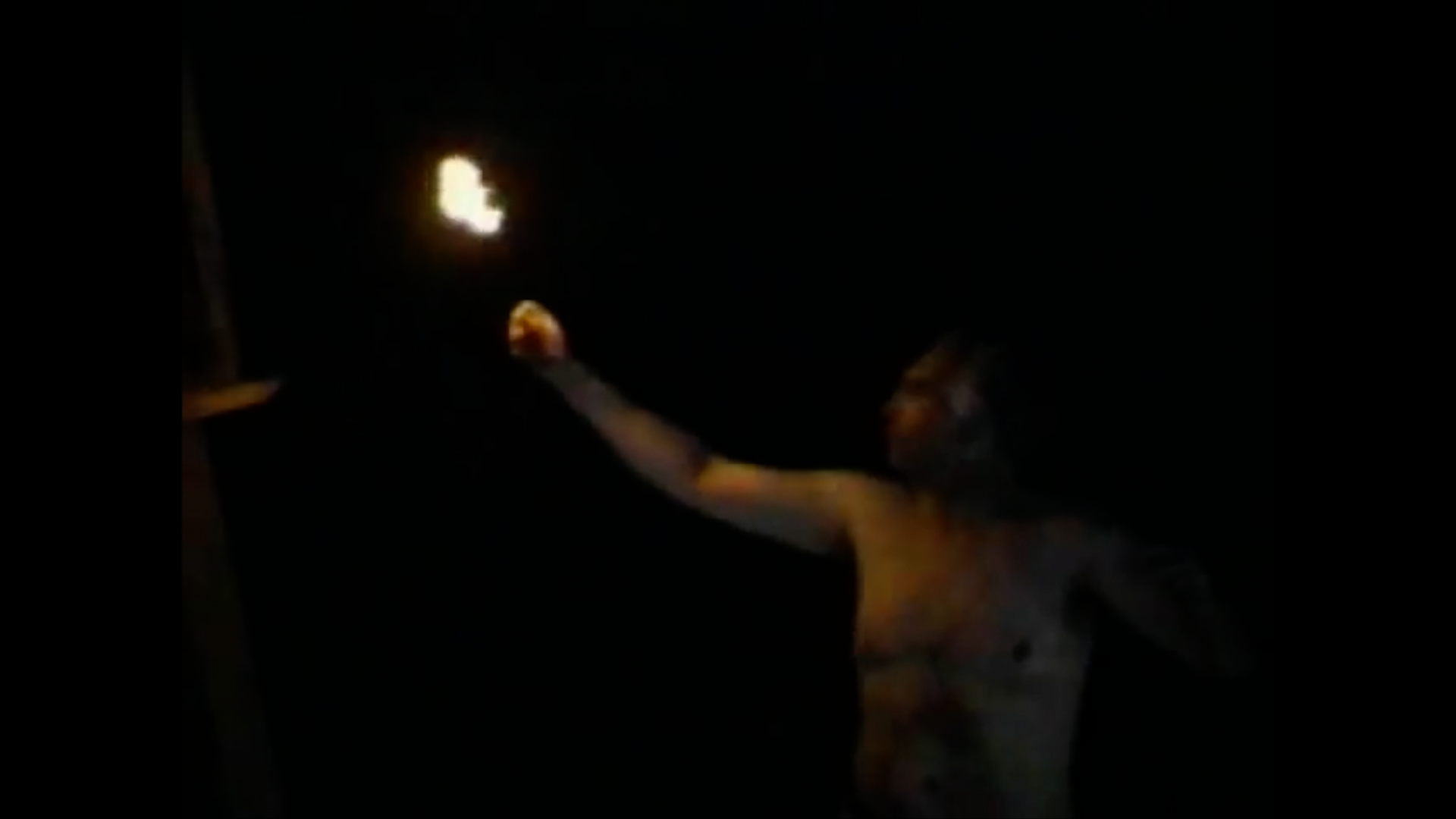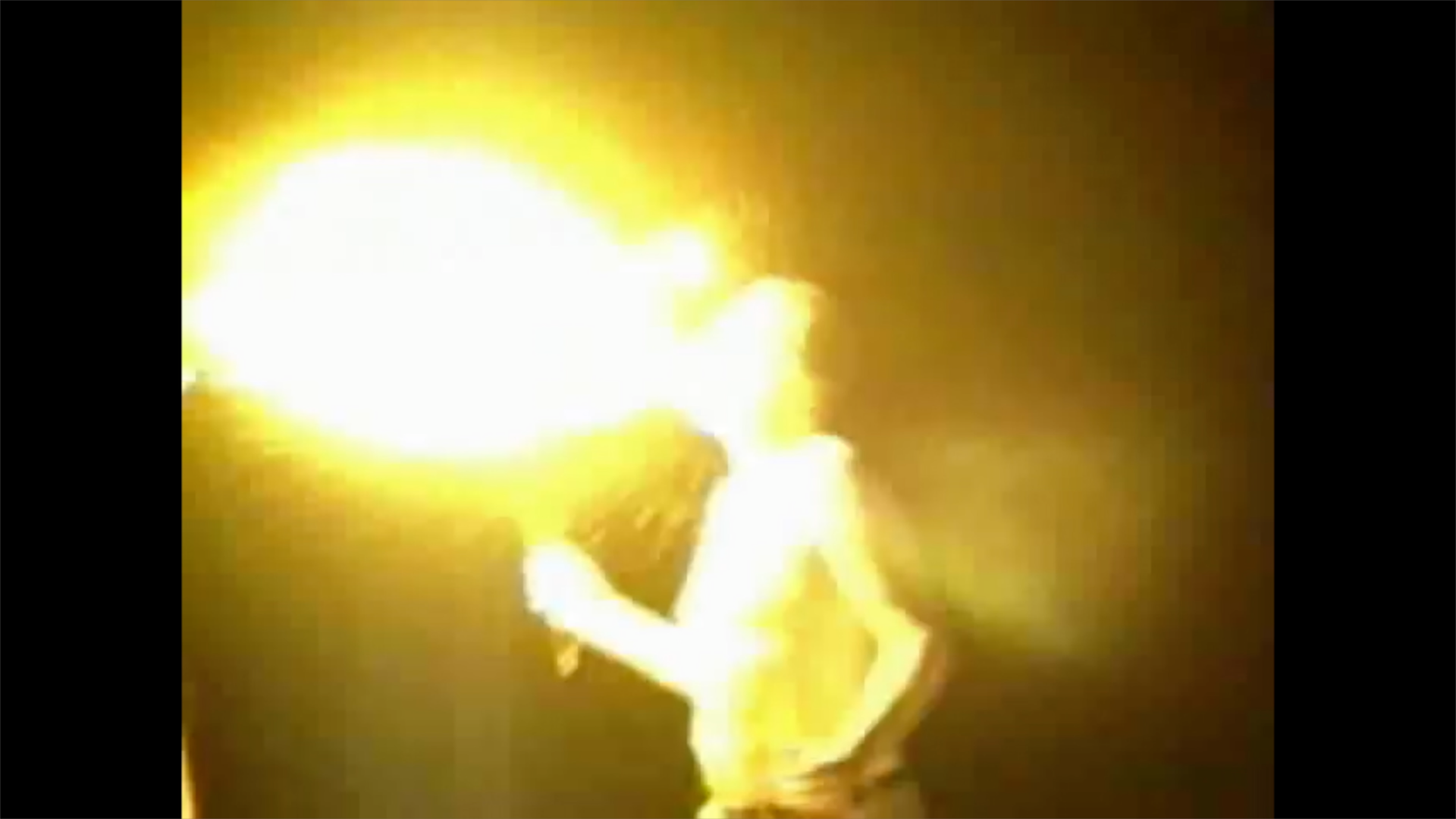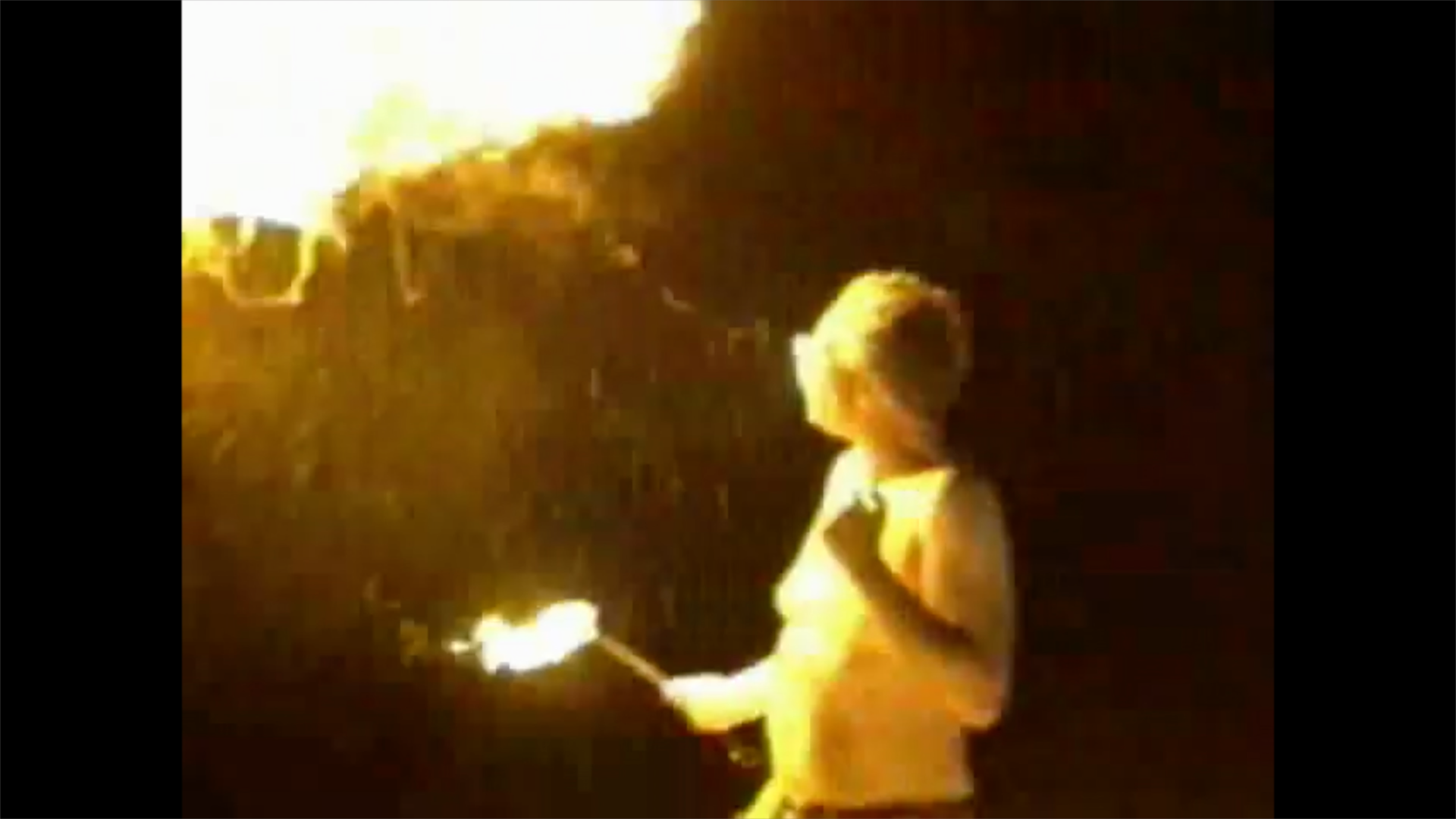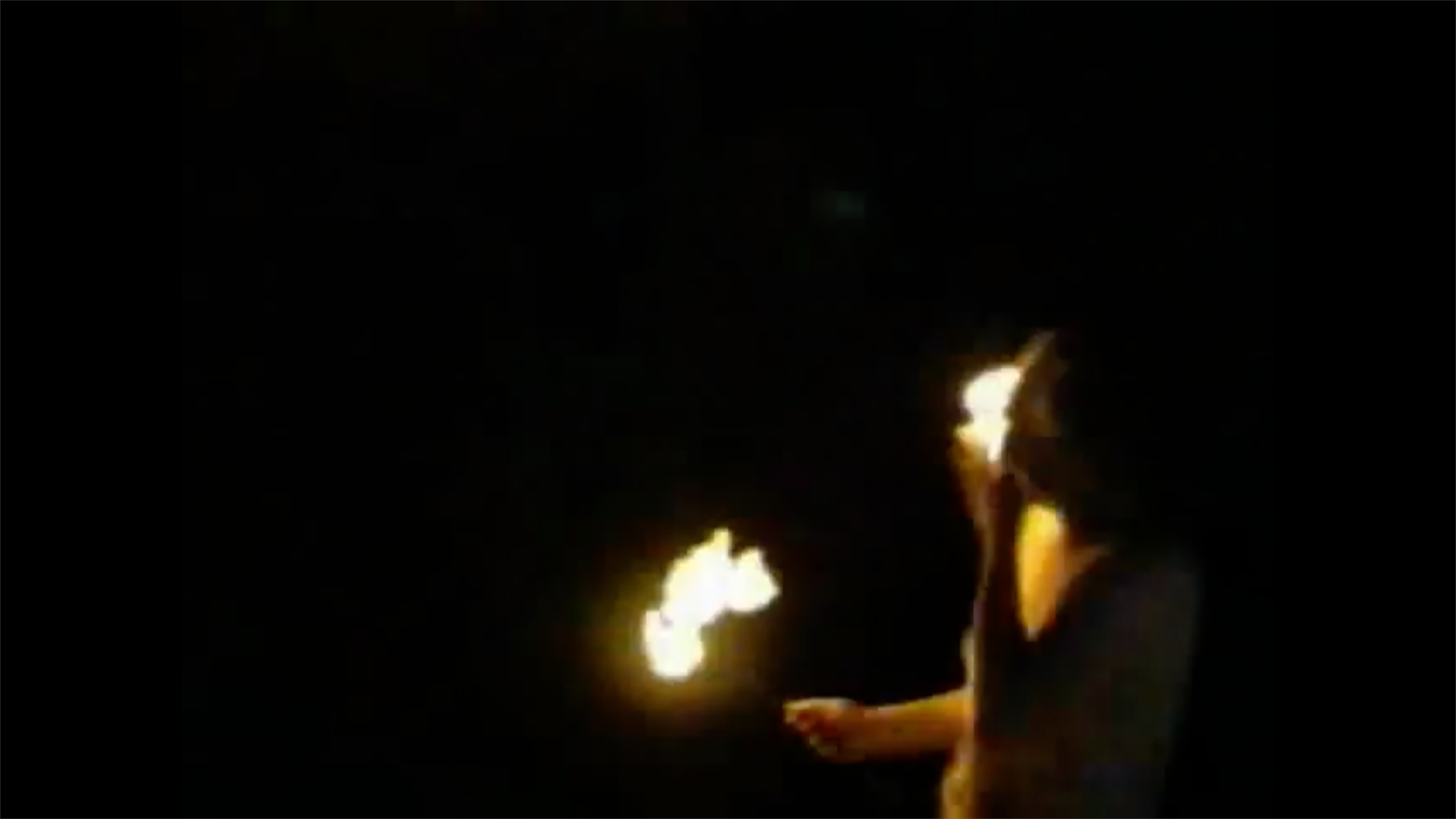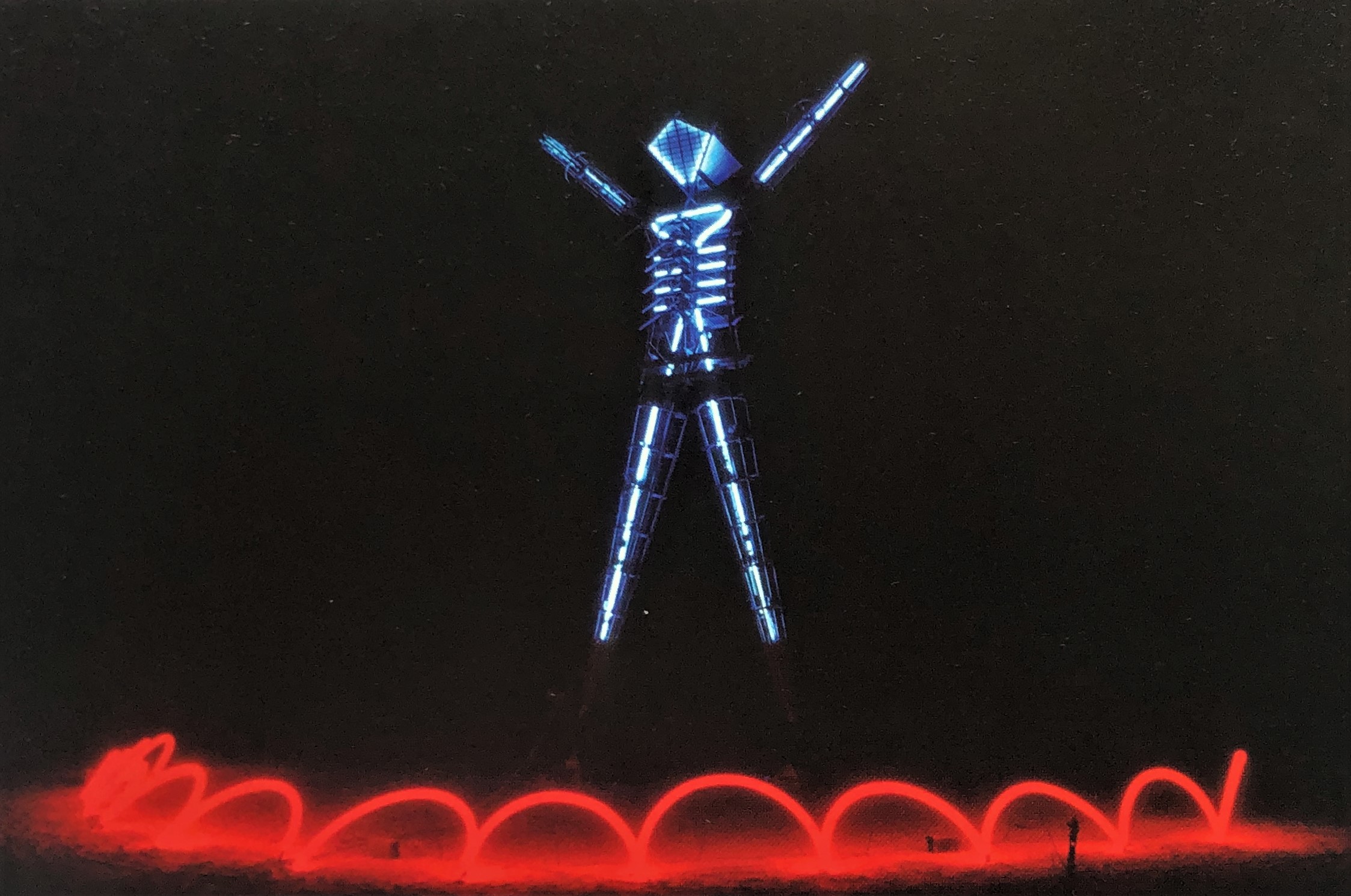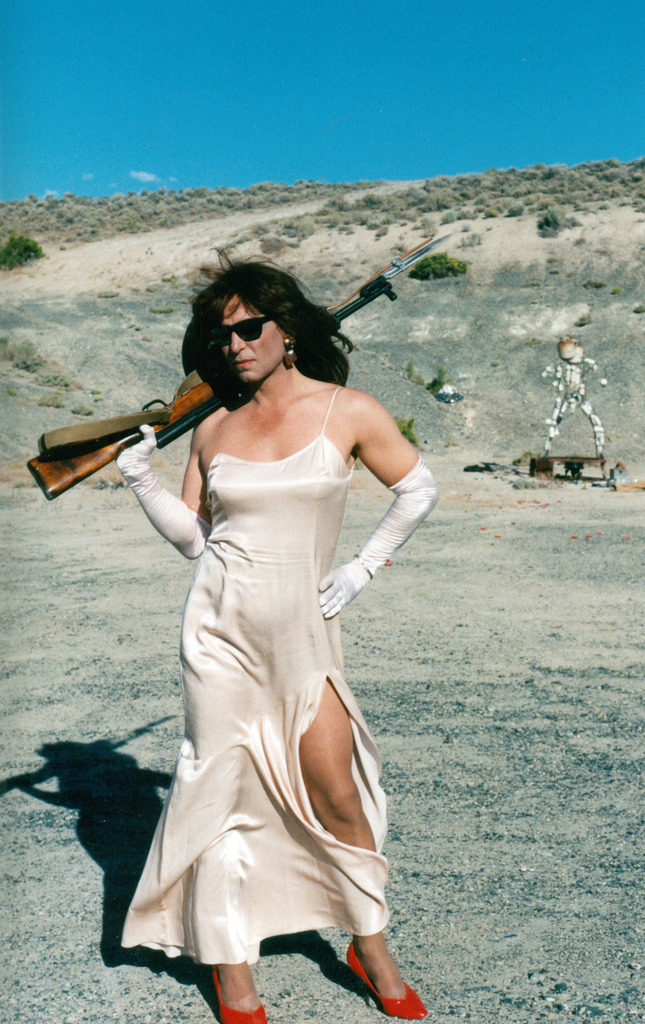Early Years on the Playa: 1990 to 1992
The Aftermath of the Failed Baker Beach Burn
After the police disrupted what would be the final gathering on Baker Beach, the Man was dismantled and taken back to where it had been shown at an art preview show: a lot on 350 11th Street (across the street from Slim’s night club).
While at Baker Beach, John Law, P Segal and Kevin Evans, all members of the Cacophony Society discussed with Larry Harvey the idea of bringing the Man to Black Rock Desert to burn.
Jerry James and the Cacophony Society had all already been to Black Rock Desert. John Law had been taken out there in 1987 and 1988 by a monster truck enthusiast. James and a handful of Cacophonists, including P. and Kevin Evans had been there the prior Labor Day for a gathering of wind sailing sculptures coordinated by Mel Lyons (also known as Mel Function) done in collaboration with a pottery maker named John Bogard who lived in nearby Gerlach. Lyons and Bogard had already been using Black Rock for weird art events, including a giant croquet game using trucks as mallets that had made the pages of Sports Illustrated.
P, Law and Kevin Evans had already been planning a Cacophony excursion to Black Rock Desert before the aborted Baker Beach burn. So bringing the Man as one of the things to do in the desert seemed like a natural fit. Lead by Law, Evans and P, the Cacophony Society began to have planning events for “Bad Day at Block Rock, Zone Trip #4”.
A group home rented by P. on Golden Gate Avenue near Baker Street had already become meeting place and hangout for the Cacophonists, and it became the headquarters for planning the desert excursion. (Many of P.’s writings can be found here, and the experiences during the Golden Gate Avenue period are collected here.)
In August 1990, right before the “Bad Day at Block Rock” event, the Man was still stored at in the paid parking lot across from Slims. According to John Law: the parking lot owner cut up the legs with a chainsaw one night when nobody else was around, essentially destroying the Man. Jerry James had secured a parking spot, but the legs were sticking out, into the next rentable space. “Ya gotta understand,” John Law says, “we were so fuckin’ broke it was retarded. So getting just one parking space to put the Man in was kind of typical.”
What Happened Between Larry
and Jerry
By this point Larry and Jerry had a falling out. In the prior year there had been growing tension over Jerry’s perception that Larry was taking overdue credit for Burning Man, while discounting his own efforts and those of Mike Acker who had contributed significantly to the construction of the Man. And then in late 1989, he and Larry had a personal conflict which ended their friendship. Jerry at that point did not plan to having anything further to do with Burning Man so Law then supervised the rebuilding of the Man after hours in the sign shop he worked in, the American Neon Sign Company. When discovered by his boss, Law showed him the first news clip, to convince him there was a sensible, media-approved reason for what he is doing.
1990: First Year on the Playa
1990: A Detailed Account
The Event is Announced
The first official announcement of the three day playa event was contained in the September 1990 edition of Rough Draft, the “Official Organ of the SF Cacophony Society”.
Carrie Galbraith had derived the idea of a “zone trip" from Andrei Tarkovsky’s Stalker, a beloved art-school film that features a mysterious Zone that looks like the rest of the world but in which bizarre, inexplicable things occur.
A caravan of 89 Cacophonists drove from San Francisco the meeting point in Golden Gate Park around toward Black Rock desert, departing around 11 p.m. at night. John Law drove the Man in a 30' yellow rented Ryder truck. Around 4 a.m. they took a rest break at the Circus Circus parking lot in Reno and around 5:30 a.m. reach Gerlach. Some stopped at Bruno’s restaurant there for breakfast. They then drove 11.7 miles past town to an accessible turnoff onto the Black Rock Desert, where there was a stack of tires. They took a right turn and left the pavement and headed 5 miles into the desert, before heading due north for 3 miles. At one point, they all got out of their cars. Michael Mikel drew a long line in the plays surface, and the Cacophonist, holding hand, walked over it as one - entering the Zone. In total 100 to 120 people would join the weekend festivities at Black Rock Desert.
Zone Trip
An established Cacophony tradition, the Zone Trip is an extended event that takes place outside of our local area of time and place. On this particular expedition, we shall travel to a vast, desolate white expanse stretching onward to the horizon in all directions. . . . A place where you could gain nothing or lose everything and no one would ever know. A place well beyond that which you think you understand. We will be accompanied by the Burning Man, a 40- foot- tall wooden icon which will travel with us into the Zone and there meet with destiny. This excursion is an opportunity to leave your old self and be reborn through the cleansing fires of the trackless, pure desert.
Read P’s Take on Zone Trip #4
In 1990, and in the next few years to follow, the culture at Burning Man was one of calculated wackiness and zaniness. Formal clothing and a formal cocktail party in the desert was typical fun. Driving as fast as your car will go in a straight line was prime fun. There were a few dogs. And some guitars. Amplified music consisted of a couple “boom boxes” playing mix tapes, of the Who, Captain Beefheart, and a camp favorite, Devo. The food, for the most part, wasn’t too goods. Freeze dried camping food was common, although hot dogs and the like were also on the playa. Larry sometimes responded to those who reminisced about the “good old days” of early Burning Man… “Sure it was a blast. If you were lucky you could get someone to drag you around on a tarp behind their car.”
The camp consisted of a small gaggle of tents, one Winnebago RV, a shade structure which consisted of a parachute material draped over stage trusses, with a pirate flag raced above it.
A big draw in the early years on the playa were the hot springs around Black Rock. Especially the spectacular Fly Hot Springs.
Larry noted that the nothingness of the desert contrasted sharply with anything that does exist there. “Something so very large and so startlingly like ourselves just seemed numinous. It was a breathtaking thing.“
Not everything went to plan on the trip (and to be frank, there wasn’t much of a plan). One planned activity, watching the original “Bad Day at Black Rock” movie was canceled because the one generator to run the project didn’t work.
During the first year at Black Rock a few people realized that combining the dust with water made a deliciously gooey slick mud that dried and flaked and transformed you into a bizarre, primitive creature of the earth, a Mud Person. Kevin Evans and Sebastian Hyde show off the look.
On the night of the Burn, Dean Gustavsson manned his full drum kit to signal the start of the festivities.
The first time the Man burned in Black Rock, his burner was also burned. Dave Warren, a founder of the Suicide Club, and a fire performer who had ignited the 1989 Man (and stood ready for the 1990 Man) spewed flames from his mouth to ignite the figure, and the wind blew the fire back into his face. No permanent damage was done to the flesh man, and the wood one burned to the ground.
When the man went up on flames, people spontaneously began to dance and walk round the man, in a counter clockwise circle. The mood was high, and when the burn was over, Larry excited exclaimed that they had to repeat the event in the following year.
1991: The Neon Man
The experience at 1990 was positive, with Larry Harvey and most participants vowing to return for labor day weekend, 1991. The Cacophony Society again was heavily involved, advertising the event to its members, and helping spread news via word of mouth. Around 250 participants showed up this year, although the early year head counts are pretty speculative.
While Burning Man had received some press attention in 1989 and 1990 for the Baker Beach burns, in 1991, it received a major boost. The Capp Street Project provided Burning Man a grant to do an installation of the man on a barge at Fort Mason in San Francisco (the raising of the man is captured in this very poor quality video). This event helped break the news of Burning Man outside of the limited circle of people who were in some way connect to the Baker Beach Burns or the Cacophony Society.
The 5:04 Special
The Playa’s First Art Car
In 1991 Michael Mikel brought his “new” car, the 5:04 Special to the Playa for the first time. The back end of the car had been crushed during the San Francisco earthquake, and he had restored the quirky vehicle. It worked well on the playa, and the back end made for a perfect perch to shoot from at the Drive By Shooting Range.
Annie Coulter. The first Burning Man Fashion show was held for the first time at 6 pm on Saturday, 1991, with the sun begging to set
Labyrinth/talking rock oracle by Dean G.
Elvis camp
Shantytown camp
LA Cacophony clown heads/fireworks/skulls
Desert Shower
Rev Al of LA Cacophony wears tire mid-waist with burning flares.
Bill Binzen wood frame structure in center camp.
The look and feel of the 1991 event was fairly close to the 1990 gathering. The crowd was larger, but the days were still mainly spent talking, driving on the playa or visiting the local hot springs. There were some guns, as in the prior year. The one Winnebago RV returned. The yellow Ryder truck that carried the man was back too. The biggest aesthetic change was John Law’s addition of Neon to the Man, which was still being constructed under Dan Miller’s lead. Crimson Rose attended her first burn, doing a choreographed dance, and having the honors to ignite the man.
1992: Burning Man is a Festival
Black Rock Gazette
In 1992 Larry had dubbed the event the “Black Rocks Arts Festival”. The name didn’t stick, with almost everyone calling the event “The Burning Man”. It wasn’t for a few more years that “The” was widely dropped from “Burning Man” when referring to the event.
1992 was the year when the event organizers thought about adding civil amenities on the Playa. Michael Mikel formalized his role as chief “lost person rescuer” and along with Rob Schmidt, formed an eight-person band of “Rangers”, which continues today as the Black Rock Rangers.
Mikel also published the first Black Rock Gazette, a single page, single edition release.
There was a central message board, where one could place notes, and get updates. Among the messages one might find on the board in 1992 were occasional requests to buy or sell psychedelic mushrooms and other similar items. There was a semi-official volunteer medical staff of one, Dr. Jack McCloskey.
1992: Black Rock Arts Festival
More details on 1992
The Burning Man gate was slightly more serious this year, and was operated out of a small silver trailer loaned for the purpose by Flash (which would soon become the “Burning Man Trauma Unit”).
Some reports claim this was the only RV at Burning Man for several years. Not true, a lone Winnebago, was present as well for the first two years, before additional RVs appeared in 1992.
And, perhaps as something of a joke, the first DJs appeared on the playa. The music encampment was positioned a mile away from center camp, and was not particularly well-received. The first DJ set had no participants other than the DJ himself, Terbo Ted, who is still an active DJ and generally creative person. Burn.life has a wonderful interview with Craig Ellenwood a/k/a DJ Niles who brought the first DJ sets to Burning Man.
So in 1992 I picked up a flyer from The Cacophony Society which was this underground org in San Francisco that did flash mob type things and weird art prank projects. At the bottom was a blurb about an event they were doing called Burning Man. I was part of an underground rave called Mr. Floppy’s Flophouse in Oakland and was a DJ and VJ. I thought what a cool thing to marry up with!
I arranged a meeting with Larry Harvey and he invited me over to his kitchen and I pitched him the idea of bringing a sound camp out to the playa. He thought it was a great prank and that things had gotten a bit complacent at Burning Man. He warned me that a lot of the people may rebel against amplified music but that we should set up exactly one mile from center camp and do our thing. He gave me a stack of tickets to sell for $20 each and I sold about 30 of them. Honestly, we couldn’t give them away - it was too far for people, nobody had heard of Burning Man and the self-reliance part of it was something new to people. ~Craig Ellenwood a/k/a DJ Niles (via Burn.life)
Kimric sends firecrackers to the heavens (with Rev. Al and Little Joe).
By 1992, guns were more common, and fires were being complemented with explosions via home made gas bombs, and more sophisticated pyrotechnics. Kimric Smythe build a wall of fire with a long line of sawdust and kerosene, a flat plane of flames bursting abruptly from the ground. In later years he (and then he and his wife) would cover himself in fireworks, light them and dance around the base of the man in his persona as “The Exploding Man”.
In 1992 the first artist not from the SF Cacopony scene arrived at Burning Man. Serena de la Hay came from England and made human-sized wickers on-site. She spent much of the summer living in one of the Cacophonist’s house (Nancy Phelps), working on them there as well.
The People on the Playa
By 1992, Burning Man was developing a distinct culture. A distinctly non-hippie, guns and fire, fast cars and dirt, with increasing nudity. It’s worth taking a moment to look at some people who shaped these early days.
Perhaps not surprising, the group of people who attended the first playa event in 1990 went on to significantly shape the future of the event. On the day of the Summer Solstice, 1990 on Bakers Beach, Burning Man consisted of Larry Harvey, with his roommate Kevin Miller leading construction efforts. (Jerry James, disillusioned, had departed the project, although he was present for the event.) But 1990 at Black Rock Desert was, by almost any measure, a Cacophony event, which happened to involve burning a wooden effigy. The attendance list was almost all members of the Cacophony Society. This group included John Law and Michael Mikel (going by Michael Michael at that point). It also included other people whose names would become familiar in early BRC lore: Kimric Smthye, Steve Mobia, Peter Doty, Kevin Evans, Sebastian Hyde and others.
Here’s a look at a few of the key players.
Michael Mikel
Michael Mikel a/k/a Danger Ranger
Michael Mikel published the first notice about the burn in the Cacophony Society's 1989 newsletter permanently entitled "Rough Draft." He drew the line in the dust in 1990 welcoming the Cacophonists to the BRC zone.
He was responsible for a number of Burning Man "firsts." In 1991, he established the first art car, the “5:04 PM”, a dented up, but still operable, vehicle that had been crushed by a fallen piece of structure during the Bay Area's 1989 Loma Prieta earthquake.
In 1992, when he and Rob Schmidt began acting as the Black Rock Rangers. They mainly patrolled the borders surrounding the civilizations, and rescuing people who had gotten lost or had a mechanical breakdown. Michael adopted the identity of Danger Ranger, by which he is widely known.
In 1992 he also began edited the first on-playa newspaper.
In 1995, he developed the Burning Man logo design, which has become the symbol of the Burning Man community. He introduced containerized storage and transport in 1997, and instituted the first perimeter radar system for Black Rock City in 2000.
Steve Mobia
Steve Mobia
Steve Mobia, a Suicide Club alumnus having his first experience with the Man, saw the fireworks and flares in his head shoot off as the fire claimed him and reflected that they were the final thoughts in the Man’s head, winged heavenward. Mobia noted that the Man inspired an awe that approached religion.
Steve Mobia arrived in San Francisco in the late seventies after being thrown out of college in Long Beach for a bit of performance art that accompanied a poem he read to a class. He urinated into a bucket, filled a quirt gun with the effluent, and began firing off over his fellow students’ heads. Then he crushed three mice on a table. Maybe San Francisco was a better for him anyway. He went there to pursue his interest in experimental film. (Some of his work can be viewed here).
Mobia became one of Burning Man’s first civic functionaries: the lamplighter, the one who lit the kerosene lamps that hung from posts on a path toward the Man. As the encampment/city grew and the need to demarcate roads grew with it, Mobia soon became chief of a band of lamplighters. He’s retired now, but the tradition has continued. Clad in flowing robes with flames that rise from the hem, hundreds of monastic volunteers silently trudge through BRC at dusk every evening, bearing over their shoulders poles from which hang the oil lanterns that they hoist to the lamp spires.
What Was There to Do?
After the first year on the playa, people upped their game on distractions over the long Labor day weekend.
Well a big thing during those years was guns. Not a large portion of the Burning Man population in the early 90s actually participated in shooting guns, but the Drive By Shooting Range was the flashy wackiness in rarefied form.
The Drive By Shooting Range
The Drive By Shooting Range
By 1992 Drive-by Shooting Range was established on the Playa. It was miles across the playa by the side of the dirt road leading toward Frog Hot Spring, a small, warm, sulfurous pond beneath a shade tree.
JD Boggman
Manager, Drive-by Shooting Gallery
The first Drive-by Shooting Range was managed by Joe Fenton, a former army man who fell in with Cacophony. By the late nineties, he was a higher-up in the Black Rock Rangers, using the playa name J.D. Boggman. He was initially refused entrance to the Black Rock Rangers: “They wouldn’t let me be a Ranger until the Burn in ‘94… Michael said I was too aggressive. And he was right, I was. I didn’t take shit, always packed guns. Even if I was wearing a suit, I’d have a shoulder holster. Hey, I’m in the middle of nowhere with a bunch of acid heads - I’m going home alive. Fuck you, I don’t care what your voices tell you to do. You’re not doing it to me.” (He later left the organization after a public altercation with another Black Rock worker).
At the Drive By Shooting Range, you could set up anything you wanted and shoot at it on bike or car. Michael Mikel’s prized chariot, the 5:04 Special, was a favorite out at the range. It was an Olds Cutlass Supreme that had been crushed by a brick wall from during the 1989 Earthquake, which occurred at 5:04 pm.
Kevin Evans, who Mikel often let drive the car, recalls sending families of strangers into tearful panics when he’d innocently pull over on long road trips to picnic in the grass. They were certain they had stumbled upon a horrific accident scene.
Also involved in the Drive By Shooting Range was Kimric Smythe, a former air force man and an explosive expert from Survival Research Laboratories (SRL). Kimric was responsible throughout the nineties for the pyrotechnics on the Man, along with his father Bill, a former United Nations functionary. SRL never had a presence at Burning Man (despite erroneous press reporting to the contrary).











